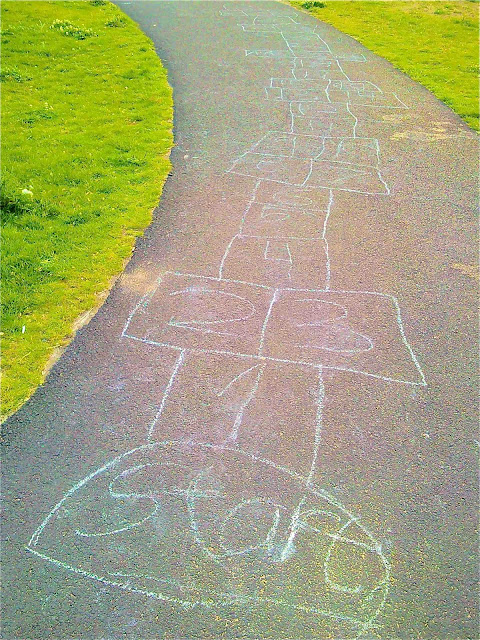Virion polypeptides
HSV-1 virions has been suggested to contain at least 30 distinct proteins.
They were designated VP and given serial numbers.
All of the virion proteins were made after infection, and no host proteins could be detected in virion preparations.
At least 11 are on the surface of the virion (accessable to antibody) and at least 10 are glycosylated.
GLYCOSYLATION - the enzymatic process that links saccharides to produce glycans, attached to proteins, lipids, or other organic molecules.This enzymatic process produces one of the fundamental biopolymers found in cells (along with DNA, RNA, and proteins).
Glycosylation is a form of co-translational and post-translational modification. 1]
The majority of proteins synthesized in the rough ER undergo glycosylation.
It is an enzyme-directed site-specific process, as opposed to the non-enzymatic chemical reaction of glycation.
Glycosylation is also present in the cytoplasm and nucleus as the O-GlcNAc modification.
Five classes of glycans are produced:
- N-linked glycans attached to a nitrogen of asparagine or arginine side chains;
- O-linked glycans attached to the hydroxy oxygen of serine, threonine, tyrosine, hydroxylysine, or hydroxyproline side chains, or to oxygens on lipids such as ceramide;
- phospho-glycans linked through the phosphate of a phospho-serine;
- C-linked glycans, a rare form of glycosylation where a sugar is added to a carbon on a tryptophan side chain;
- glypiation, which is the addition of a GPI anchor that links proteins to lipids through glycan linkages.
The carbohydrate chains attached to the target proteins serve various functions.[2]
For instance, some proteins do not fold correctly unless they are glycosylated first.[1]
Also, polysaccharides linked at the amide nitrogen of asparagine in the protein confer stability on some secreted glycoproteins.
Experiments have shown that glycosylation in this case is not a strict requirement for proper folding, but the unglycosylated protein degrades quickly.
Glycosylation may play a role in cell-cell adhesion (a mechanism employed by cells of the immune system), as well.
N-linked glycosylation
N-linked glycosylation is important for the folding of some eukaryotic proteins.The N-linked glycosylation process occurs in eukaryotes and widely in archaea, but very rarely in bacteria.
In Eukaryotes, most N-linked oligosaccharides begin with addition of a 14-sugar precursor to the asparagine in the polypeptide chain of the target protein.
The structure of this precursor is common to most eukaryotes, and contains 3 glucose, 9 mannose, and 2 N-acetylglucosamine molecules.
A complex set of reactions attaches this branched chain to a carrier molecule called dolichol, and then it is transferred to the appropriate point on the polypeptide chain as it is translocated into the ER lumen.
There are three major classes of N-linked saccharides resulting from this core: high-mannose oligosaccharides, complex oligosaccharides and hybrid oligosaccharides.[2]
- High-mannose is, in essence, just two N-acetylglucosamines with many mannose residues, often almost as many as are seen in the precursor oligosaccharides before it is attached to the protein.
- Complex oligosaccharides are so named because they can contain almost any number of the other types of saccharides, including more than the original two N-acetylglucosamines.
If the saccharide is relatively inaccessible, it will most likely stay in its original high-mannose form.
If it is accessible, then it is likely that many of the mannose residues will be cleaved off and the saccharide will be further modified by the addition of other types of group as discussed above.
The oligosaccharide chain is attached by oligosaccharyltransferase to asparagine occurring in the tripeptide sequence Asn-X-Ser or Asn-X-Thr where X could be any amino acid except Pro.
This sequence is known as a glycosylation sequon.
After attachment, once the protein is correctly folded, the three glucose residues are removed from the chain and the protein is available for export from the ER.
The glycoprotein thus formed is then transported to the Golgi where removal of further mannose residues may take place.
However, glycosylation itself does not seem to be as necessary for correct transport targeting of the protein, as one might think. Studies involving drugs that block certain steps in glycosylation, or mutant cells deficient in a glycosylation enzyme, still produce otherwise-structurally-normal proteins that are correctly targeted, and this interference does not seem to interfere severely with the viability of the cells.
Mature glycoproteins may contain a variety of oligomannose N-linked oligosaccharides containing between 5 and 9 mannose residues. Further removal of mannose residues leads to a 'core' structure containing 3 mannose, and 2 N-acetylglucosamine residues, which may then be elongated with a variety of different monosaccharides including galactose, N-acetylglucosamine, N-acetylgalactosamine, fucose and sialic acid.
GalNAc, glucose, and rhamnose linked to asparagines have been observed as well, although mostly in less complex organisms or bacteria. Glucose linked to the guanidinium group of arginine in sweet corn amyelogenin is the only reported example of N-linked glycosylation on an amino acid other than asparagine.
O-linked glycosylation
O-N-acetylgalactosamine (O-GalNAc)
O-linked glycosylation occurs at a later stage during protein processing, probably in the Golgi apparatus.This is the addition of N-acetyl-galactosamine to serine or threonine residues by the enzyme UDP-N-acetyl-D-galactosamine:polypeptide N-acetylgalactosaminyltransferase (EC 2.4.1.41), followed by other carbohydrates (such as galactose and sialic acid). This process is important for certain types of proteins such as proteoglycans, which involves the addition of glycosaminoglycan chains to an initially unglycosylated "proteoglycan core protein." These additions are usually serine O-linked glycoproteins, which seem to have one of two main functions.
One function involves secretion to form components of the extracellular matrix, adhering one cell to another by interactions between the large sugar complexes of proteoglycans.
The other main function is to act as a component of mucosal secretions, and it is the high concentration of carbohydrates that tends to give mucus its "slimy" feel.
Proteins that circulate in the blood are not normally O-glycosylated, with the exception of IgA1 and IgD (two types of antibody) and C1-inhibitor.
















































